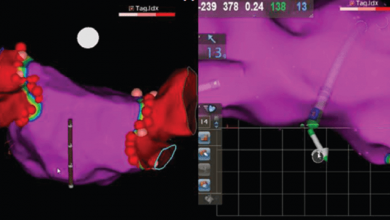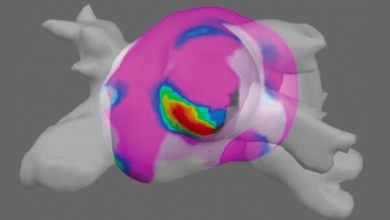Search results
Author(s):
Eduardo Back Sternick
,
Mariana Faustino
,
Frederico Soares Correa
,
et al
Added:
3 years ago
Radiofrequency (RF) catheter ablation is currently the treatment of choice in patients with accessory pathways (APs) and Wolff– Parkinson–White syndrome, and is shown to have a success rate >95 %.1 APs usually have endocardial ventricular and atrial insertions, located close to the atrioventricular valve rings, making most endocardial catheter ablation procedures relatively straightforward and…
View more
Author(s):
Stavros Stavrakis
,
Sunny Po
Added:
3 years ago
There are numerous conglomerations of autonomic ganglia on the epicardial surface of the heart, known as ganglionated plexi (GP). These GP have been shown to play a significant role in different arrhythmias, including AF. As such, GP ablation has become an adjunctive procedure in the treatment of AF. This review will present the current data on the significance of GP in arrhythmogenesis and will…
View more
Author(s):
Charles M Pearman
,
Shi S Poon
,
Laura J Bonnett
,
et al
Added:
3 years ago
The goal of arrhythmia eradication in AF continues to be elusive for cardiac electrophysiologists. Although endocardial radiofrequency (RF) catheter ablation is more effective than pharmacological management at maintaining sinus rhythm,1 it is far from perfect, especially in patients with non-paroxysmal AF.2 In an attempt to address this, attention has turned back to the surgical ablation that…
View more
Author(s):
Seigo Yamashita
,
Ashok J Shah
,
Saagar Mahida
,
et al
Added:
3 years ago
Catheter ablation therapy has been widely used for rhythm control in patients with atrial fibrillation(AF).1 Since the first report in 1994,2 several interventional techniques have been proposed for AF, including replication of the surgical Maze,2 targeting pulmonary vein (PV) foci,3 segmental ostial and circumferential PV isolation,4,5 ganglionated plexi ablation,6 linear lesions in the left…
View more
Zero X-ray Ablation
Author(s):
Giuseppe Mascia
,
Marzia Giaccardi
Added:
3 years ago
Article
Author(s):
Stavros Stavrakis
,
Sunny Po
Added:
3 years ago
Dear Sir,
We thank Dr Pachon for his interest in our manuscript.1 While we acknowledge that the concept of autonomic ablation for treatment of bradyarrhythmias was first proposed by Dr Pachon’s group,2,3 we would like to draw the reader’s attention to the methods of identifying the ganglionated plexi (GP). The original description by Dr Pachon’s group was based on Fast-Fourier Transform (FFT)…
View more
Author(s):
Laurent Roten
,
Matthew Daly
,
Patrizio Pascale
,
et al
Added:
3 years ago
With an ageing population and widespread use of implantable cardioverter-defibrillators, physicians are confronted with an increasing number of patients with symptomatic, drug-refractory ventricular tachycardia (VT). Catheter ablation is an important treatment option in the management of patients with structural heart disease and VT.1,2 In many patients, VT can be successfully ablated from the…
View more
Author(s):
Maya S Verma
,
Maria Terricabras
,
Atul Verma
Added:
2 years ago
Author(s):
Theodoros A Zografos
Added:
3 years ago
Dear Sir,
I read with great interest the elegant review by Mukherjee and colleagues on prophylactic VT ablation in the latest issue of the journal (AER 6(3)125-8).1 The concept is indeed revolutionary, and should extend the boundaries of interventional electrophysiology. However, such an approach cannot be feasible without rationalising patient selection. Current guidelines’ recommendations,…
View more













 « First
« First